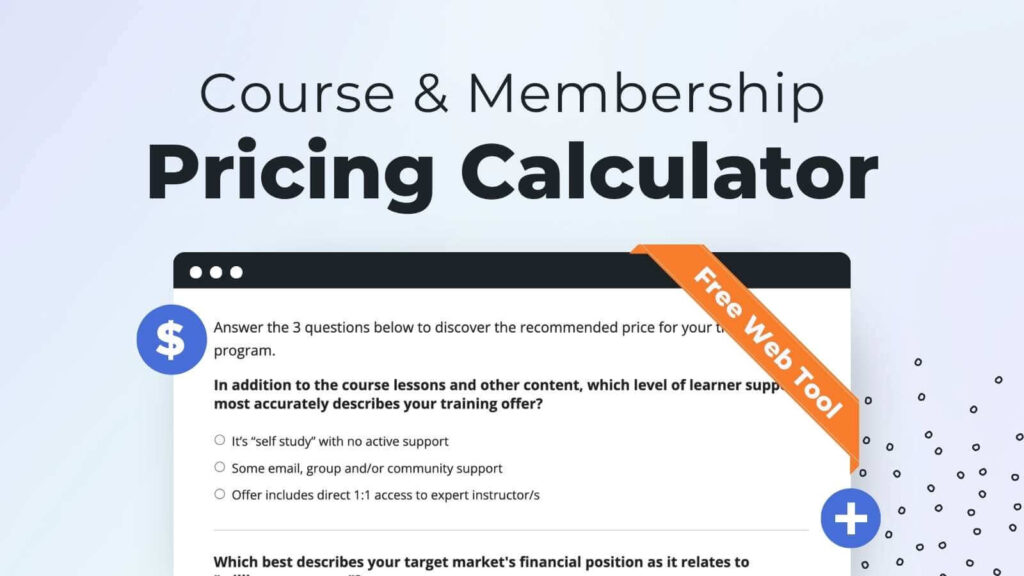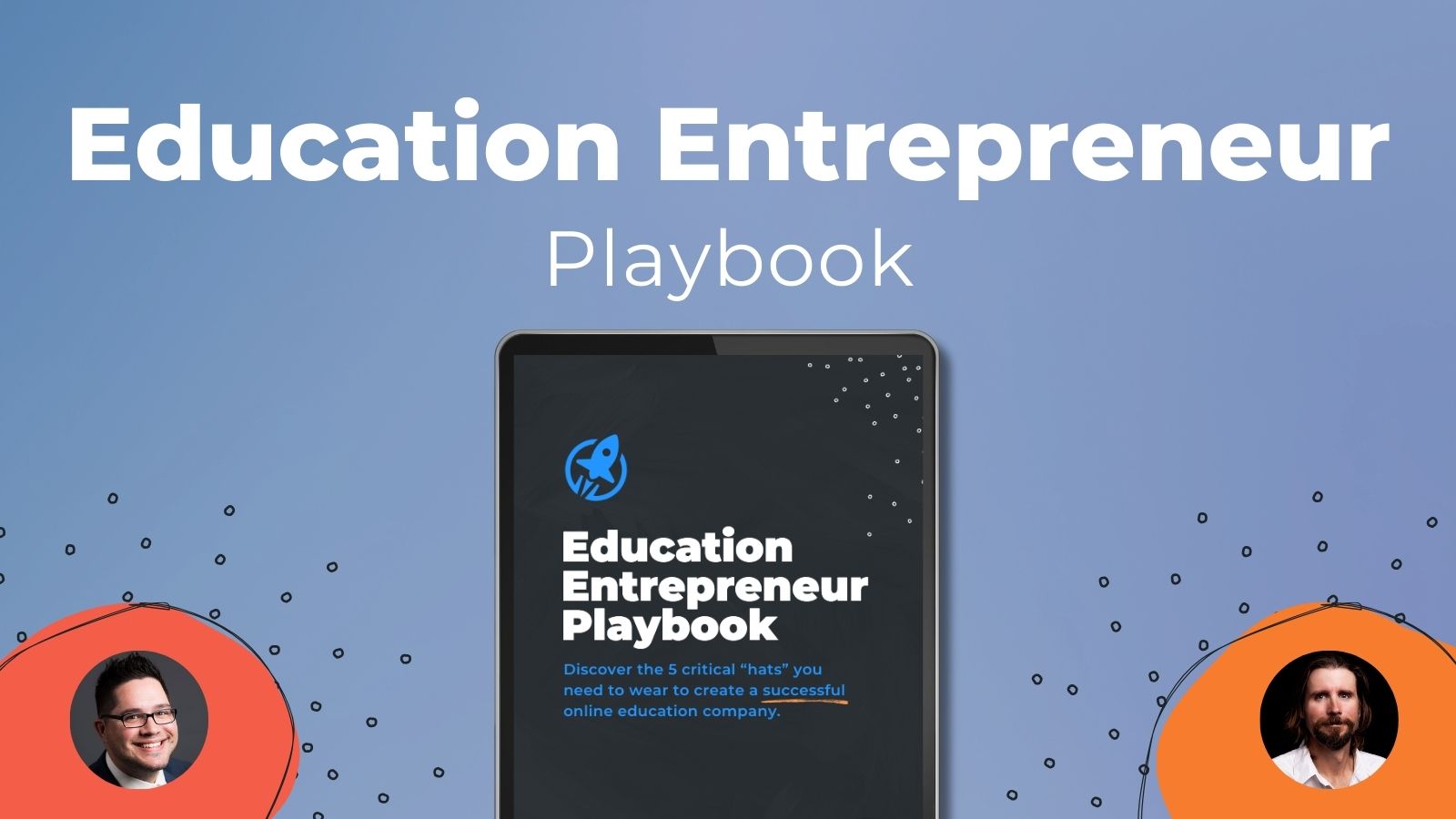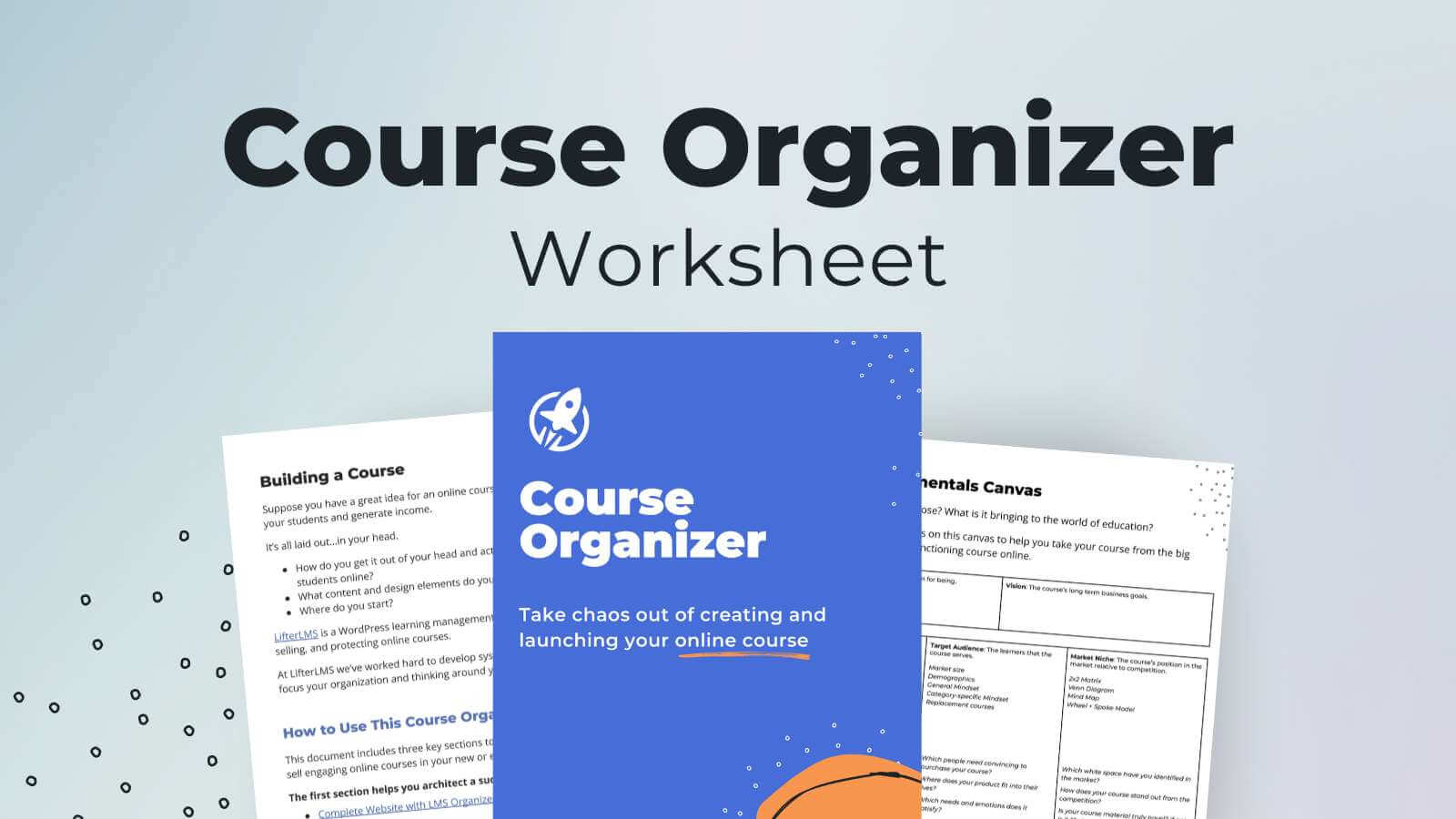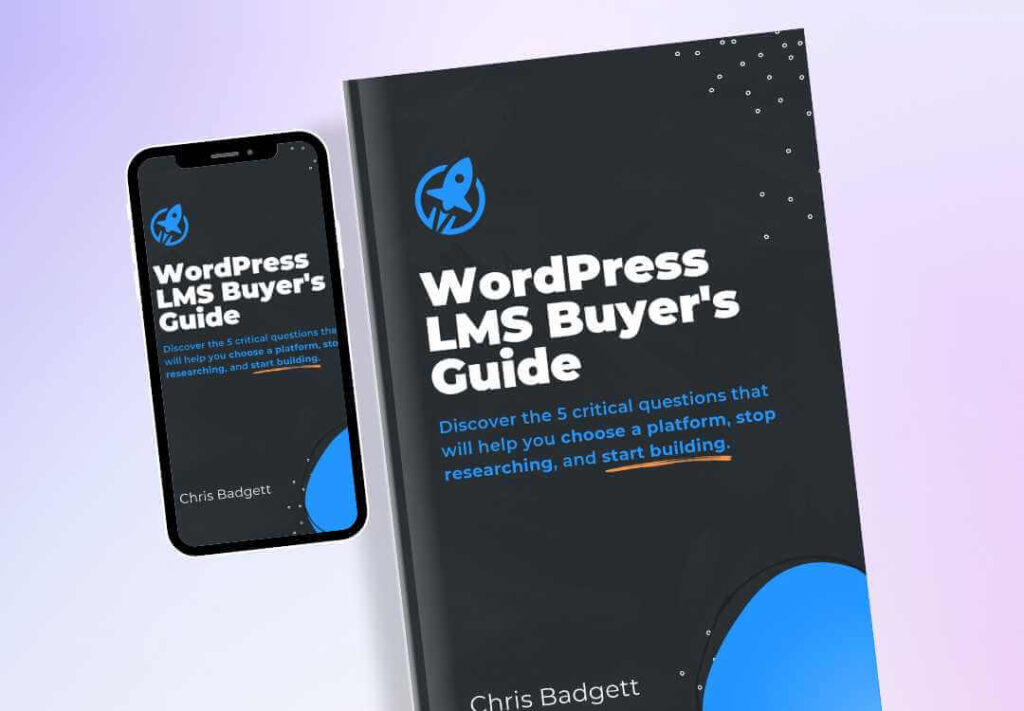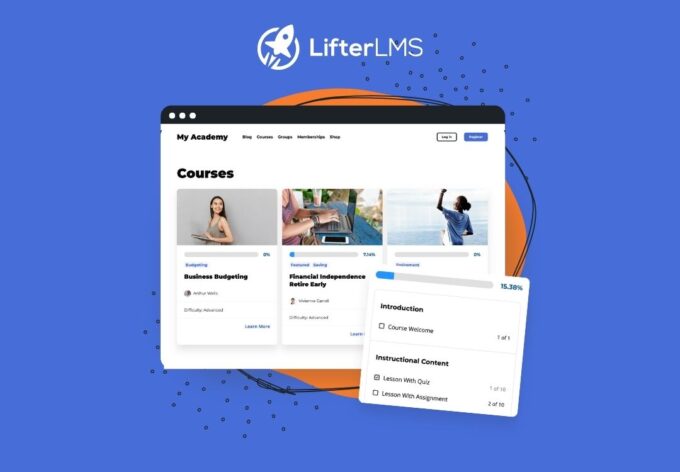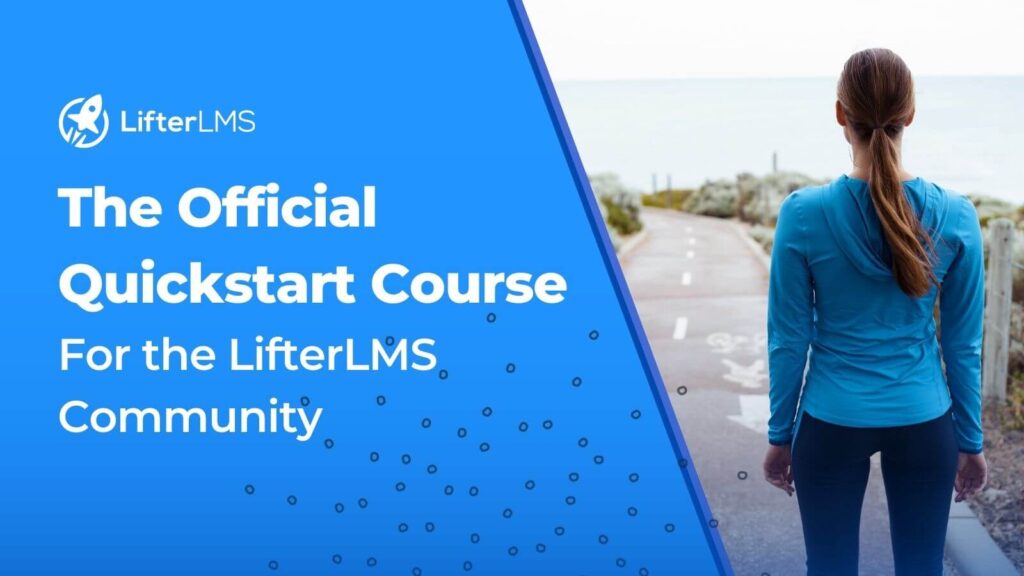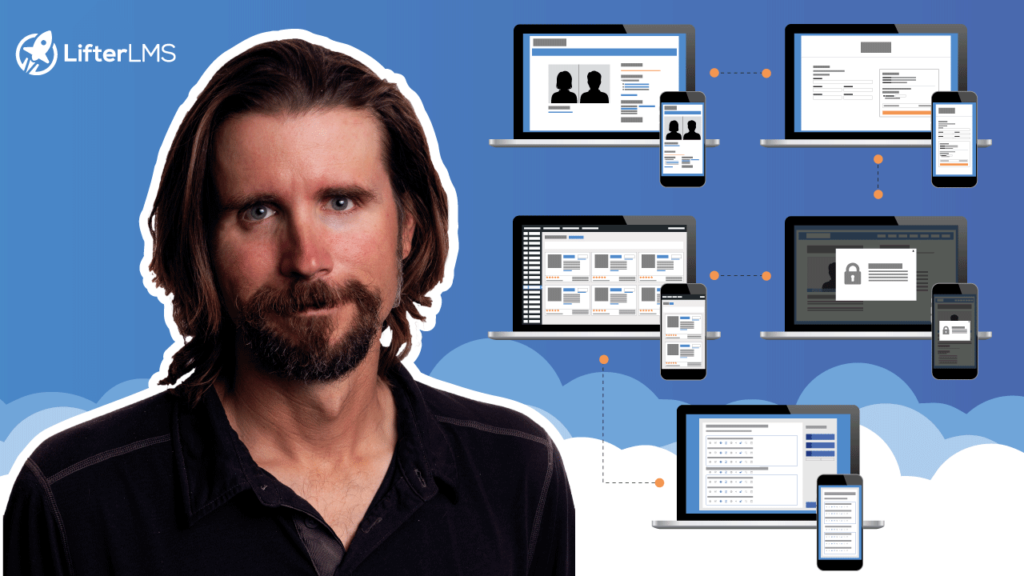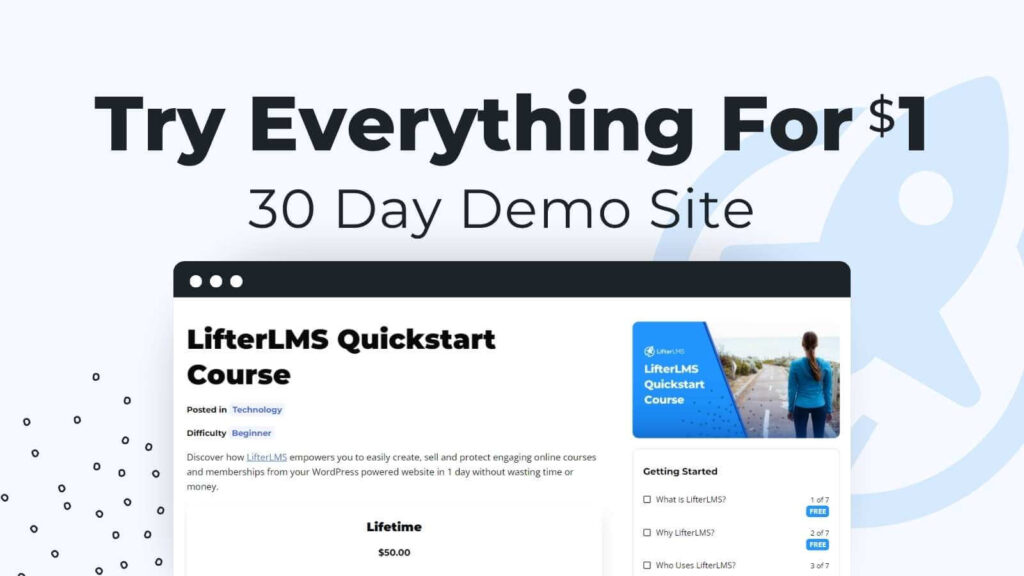Learn about how to create a mobile app for courses and membership sites with Juliana Meyer from SupaPass in this episode of the LMScast podcast hosted by Chris Badgett from LifterLMS.

At LifterLMS we get asked a lot in the WordPress world and the LMS world about how to build a mobile app. And a lot of people go down the rabbit hole, and they just end up getting stuck. Or they do some research and find a mobile app developer, and it ends up being over six figures to develop. Juliana found an easier way to make that happen, and in this episode she takes us to school on creating mobile apps the easy way.
At SupaPass, they’re really excited that they’ve been able to make a game changer for a lot of course creators who prior to finding out about SupaPass basically couldn’t afford to have their own app. And now they have some customers that actually did spend hundreds of thousands building their own technology and then realizing that there are still a whole bunch of features they needed, and maintaining it is really expensive. And they’ve gone through it all the way and came to SupaPass, because what they’ve built is better than what cost them hundreds of thousands. It’s a complete game changer for people.
SupaPass is not just for course creators. It’s really for any content that you’re making. So if you’ve got a podcast, it can also have your podcast in there. If you’ve got music, if you’ve got an audiobook, if you’ve got blogs and articles, you can store all your content together. You can build a community there and have a pay for it, or you can have a subscription. You can do patron donations, but you keep 100% of all the money. There’s no revenue share. It’s completely your platform.
To learn more about Juliana Meyer and the awesome work she’s doing to democratize app development for everyday people, be sure to head to SupaPass.com. And if you’re interested in chatting with them about your goals and challenges, feel free to message them through the website or jump on a call with them.
And at LifterLMS.com you can learn more about new developments and how you can use LifterLMS to build online courses and membership sites. If you like this episode of LMScast, you can browse more episodes here. Subscribe to our newsletter for updates, developments, and future episodes of LMScast. Thank you for joining us!
Episode Transcript
Chris Badgett: You’ve come to the right place if you’re looking to create, launch, and scale a high-value online training program. I’m your guide, Chris Badgett. I’m the co-founder of LifterLMS, the most powerful learning management system for WordPress. Stay until the end. I’ve got something special for you. Enjoy the show.
Hello, and welcome back to another episode of LMScast. I’m joined by a special guest. Her name is Juliana Meyer from SupaPass, which is an easy way to make mobile apps, and it’s also a website builder. Welcome to the show, Juliana.
Juliana Meyer: Hey, Chris.
Chris Badgett: I’m really excited to get into it with you. We get asked a lot over in the WordPress world and the LMS world, the course creation world about how to build a mobile app, and I see a lot of people go down the rabbit hole and they just end up getting stuck or they do some research and find a mobile app developer and it’s going to be over six figures to develop. You found an easier way to make that happen. Can you take us to school on creating mobile apps the easy way?
Juliana Meyer: Absolutely. So yes, so we’re really excited that we’ve basically been able to be a game changer for a lot of course creators and content creators and entrepreneurs who prior to finding out about SupaPass basically couldn’t afford to have their own app, and we do actually even have some customers that actually did spend hundreds of thousands building their own technology and then realizing that there are still a whole bunch of features they needed and maintaining it is really expensive, and they’ve actually gone through it all the way and came to us because what we’ve built is better than what cost them hundreds of thousands. So it really is a complete game changer for people.
And basically, what we’ve done is it’s so affordable that it’s basically less, it will cost you less than some of the pricing tiers on Kajabi or Teachable or some of the SaaS e-learning platforms, but with us, you literally have your own mobile app that out the books looks and feels like Netflix, Amazon Prime or Spotify.
And also, the other thing for content creators listening is that it’s not just for course creators. It’s for really any content that you’re making. So if you’ve got a podcast, it can also have your podcast in there. If you’ve got music, if you’ve got an audiobook, if you’ve got blogs and articles, you can literally have all your content together. You can build a community there. You can have a pay or you can have a subscription. You can do patron donations but you keep 100% of all the money. There’s no rev share. Literally it’s your platform.
So that’s really key to I guess why I founded the company, was to give creators and entrepreneurs complete control and complete ownership of everything in a way that they can’t get on those third-party platforms in social media and streaming platforms but where it’s yours and it’s your brand. It’s your brand and it’s yours. You search for your name in the App Store or you go to your custom domain on website and it’s all there but you haven’t had to mess about with coding or plug-ins or software updates or any of that. It’s just made for you. The same way as you’ve created a Facebook group, it’s made for you but it’s your brand.
Chris Badgett: Wow. That is awesome. Well, I get asked a lot about mobile apps, but I’m not a real mobile app expert. So I’m going to pretend like I’m the prospective customer for you because I get these questions all the time. The first one … so I have a lot of little questions just around the process and how it works.
Juliana Meyer: Awesome.
Chris Badgett: The first one is does this work with Apple and Google apps or is it … Yeah.
Juliana Meyer: Yeah, exactly. So it’s a native build. So sometimes when you buy apps from a company, it’ll be cross platform which means that basically it’s built in one code base that then is distributed across both, but the user experience in those, it feels more like a website experience rather than an app experience. Whereas, what we’ve built, they’re both completely different stacks where they’ve built natively, so we’ve built an iOS native app, which is … We’ve got two apps. There’s one for iPhone and one for iPad. And then you’ve got the Android native app, which is then specifically for the Android stack, and it means that it uses all of that beautiful native functionality. The audio player looks like a beautiful player that you get on something like Spotify.
You’ve got really great functionality like push notifications and things like that. So every time you’ve got new video or new podcast episode that comes out, you can send a push notification automatically that says, “The latest content is up,” or you can send custom ones saying, “Oh, let’s all hop into Zoom now,” or whatever it is that you’re doing. It just makes that really easy to engage your audience and your students or whoever is your audience because it’s bringing them all into one place in a really engaging way that cuts through the noise.
Chris Badgett: That’s cool. And getting set up on SupaPass, is it a SupaPass app or if I’m your customer, is it my account on the App Store or whatever?
Juliana Meyer: It’s yours. Yeah. It’s yours. So let’s say that you wanted a LifterLMS app, then you would register with an account, a developer account with Apple App Store and Google Play Store, and then we would do all the build. So basically, you’d sign up with SupaPass. You’d have your SupaPass dashboard. You control apps, really everything from that dashboard, so upload all your courses there. You can pull in your podcast automatically through the RSS. If you’ve got a podcast, you actually can create … And actually, it was interesting hearing your chat that you had a couple of episodes ago. Who was it with?
Chris Badgett: About podcasting?
Juliana Meyer: Yeah. It was the Divi Addicts podcast.
Chris Badgett: Oh yeah, Keegan Lanier. Yeah.
Juliana Meyer: Yeah. And he was saying, “Oh, it’s too much effort to create a website for the podcast.” But actually with this, literally within two minutes, you can have a beautiful podcast website that automatically pulls in all … And he was saying each time he’s got a plug-in and each time, he has to go and spend two minutes approving the episode. It automatically pulls in the episode and publishes it each time, sends out the email notifications, push notifications, post to social media, all that stuff literally out the box.
Anyway, I digressed from your original question, which was so you basically, from the dashboard, you can create all that stuff. And then with the app itself, it’s pretty much a form within the dashboard that you fill out, which includes things like what is the App Store copy? What keywords and categories do you want? Is there an age restriction for the app? That form takes about three minutes. Obviously, if you have to think about what the marketing message is, that’s going to take you longer, but if you already know what that is, literally just fill out that form, it takes you three minutes, press build and that’s it. That’s literally it. We do all of the rest of the magic behind the scenes.
So then we go and we create the builds, we create all the screenshots. For anyone that has built apps before, you’re familiar with the fact that you have to create screenshots for every single device, five to 10 screenshots for every single device that’s out there. You multiply that. You end up having to do 300, 600 screenshots for every single app release for every time you do an update. But we do all of that for you so you’re just not having to worry about any of these technical things, which normally is such a barrier when people want to make an app. You literally don’t have to worry about those things with us. You go to the Apple or Google Play Store review process and then your app is published.
And then from there, the other thing that we do once it’s live in the store is we constantly update the app. So every year, Apple brings out a new iOS update, which means that … and usually it deprecates previous things. So if you’ve got your own app that you’ve built yourself, you’ve got to then invest time basically upgrading it and rewriting bits of it to work with the new devices and operating systems. But with us, you literally just don’t have to think about any of that. Actually, probably a lot of our customers don’t even know we’re literally doing that every year all the time. We’ll do all of that for you. You just don’t need to think about it. We’re constantly adding new features, so our clients often would be like, “Oh my, gosh. Now I can do this other thing that I didn’t even know was coming and it’s just there.” It’s released. It’s just added to the suite of tools that you get to enjoy. So we really do aim to take all the pain points away, make it really, really easy.
And probably the most complicated bit is actually just creating your developer account in the first place because with Apple, you have to prove who you are and things like that. Honestly, that is, for us, the most restricting stage because we can’t make that simpler.
Chris Badgett: Yeah. And you’re giving the power to the person. It’s your account. It’s your app, so you got to set up the thing. Right?
Juliana Meyer: Well, yeah, exactly. So we want to give you all the control, but unfortunately we can’t just create the account for you, but we can do everything else and we do. And then also having your own Apple, Google Play Store account, that means that you can then see all the app downloads, see the territories, any in-app purchases that you have. You can see all of that money and you get paid that money directly. You basically have control of everything, apart from we take care of the tech for you. So yeah. And we’re constantly doing more to make it even simpler and to bring down the price even more because basically, my mission and my aim is to enable any content maker on the planet to be able to have that level of technology that Netflix or Spotify can offer your audiences. Most individual content creators can’t afford that kind of content experience for your audience, and that’s what I think, I want to level that playing field.
I want us to enable anyone to give that experience but in an affordable way that they don’t have to go through all the pain and that it’s as affordable as building something on Wix or Squarespace or WordPress wherever people currently build websites. They can actually have their own mobile app and their own website out the box for those same price points.
Chris Badgett: That’s awesome. Michael Wiley is getting excited in the Facebook group.
Juliana Meyer: Awesome.
Chris Badgett: If you have any questions-
Juliana Meyer: Hey, Michael.
Chris Badgett: … we are broadcasting. The recording of this is live, so if anybody is watching this, feel free to drop a question in the chat. But let’s talk about timeline. Let’s say I have a bunch of materials together, some video files, audios. I just know what I want my app to do and I got the content. How long from that moment to having my app is live in the app stores?
Juliana Meyer: So the answer to that question most of the time depends on you. So I’ll give you an example. So we made an app for Podfest, which they’ve actually got a Guinness World Record for that conference for the most podcasters to attend a virtual conference. So this was last August.
Chris Badgett: Okay.
Juliana Meyer: And the conference finished on a Friday. And on Monday morning, it was about 500 half an hour sessions that they’ve had through these 500 video sessions, and on the Monday morning, we started uploading all of that, creating the apps at 9:00 in the morning. By 2:00, we’ve uploaded all 500 videos, all curated, set up all the price points and products, created the build and submitted the builds to the app store by 2:00 that same day. So when you have got absolutely everything ready and you know exactly what you want it to be and do, it is possible to literally create it in 24 hours. Then after submitting it to the app stores, it can take, particularly Apple more than Google, it can take a week for them to approve it through the app store, but sometimes they can turn around in 24 to 48 hours so it just does depend. Very rarely, it can take even longer than a week if there’s some copyright that they needed to prove that you’re … Particularly if you’re a big influencer, you might to prove legally that you are who you say you are.
So the app stores can take a bit longer, but on our side, it can literally be done within a day. I would say that that’s not normal though. I think most of the time, what we see is that people aren’t quite ready with absolutely everything when they sign up. So quite often what people will do is they’ll sign up, they’ll get the initial, the homepage, landing page for the website and the podcast and other things. That usually will even for people that don’t necessarily know what else is fitting for the rest of that, that usually happens in the first 10, 20 minutes anyway. So that can go live straight away even if you’re not organized with the other stuff. And then the other stuff, it just depends, but we are talking a matter of hours once you have everything.
Chris Badgett: That’s cool. I’m not sure how it technically works, but what if I want to have, let’s say it’s a private app that I’ve already got these existing customer. Is that possible to do with SupaPass?
Juliana Meyer: Absolutely. Yes. So we work with loads of entrepreneurs who already have a really cool ecosystem, whether it’s a community on Discord or courses on Udemy or whatever it might be. There are so many different kinds of examples that we have where they then want to add the app as well. And so it’s very, very easy to invite all of those existing customers in where they’re not having … So let’s say you set up, so you’ve got a course and it’s on your website. You’ve got your LifterLMS course and then you want to get all of those students into your app as well so you’d set up-
Chris Badgett: But not the general public.
Juliana Meyer: Yeah, not the general public. Exactly. So you may want to also have the app … If new people come along and want to buy the course that they could do that within the app.
Chris Badgett: From the app side.
Juliana Meyer: Yeah, on the app side if you wanted.
Chris Badgett: Cool.
Juliana Meyer: But then all your students that already have enrolled, they’ve already paid, you literally can just … We can generate a unique link for each of them and then you just send that link to each student. They click it. It automatically redeems their access. That link is unique to them. It can’t be then reused. And then they’ve got access and that can be for … And you can really control on a really granular level what you’re giving them access to. So let’s say they bought 10 different courses. With that one link, they can then have instant access to all 10 of that content. If you maybe wanted to create a secret space that no one else can see and just that cohort, that group of users can see, then you can do that too, so you can have a unique link that’s just specifically to that secret space.
One thing that seems to be quite popular is people are doing a lot of Zoom sessions or webinars with a group of students that they’re training and then you probably don’t want to share that on a website that other people could then ever access that video even if they were paying. So you probably wanted then to share that recording with the people that were part of that session, particularly if it was an interactive session, so you can just create a space, a secret space just for the people that attended or maybe it’s a weekly thing so you do it across all the videos that they attend. And then you just give them access and then every time you have another session with that group, you can just then upload that and give them access.
So it’s a really, really nice way to granularly control private content, paid content. You can also have free content that has an email gateway, which is a great lead magnet and a way to grow your email list, and you can just have free content if you want to have people just come straight there, play stuff, find out more about what you’re doing. So we find that people tend to use all four different kinds of access types across different content as well. You can have infinite permutations so it’s a really nice way to curate everything.
Chris Badgett: That’s cool. What about let’s say where we sell annual subscriptions to our website and somebody churns, can we remove somebody off that we gave the unique link to, to get access? Can we kick them out of the premium stuff?
Juliana Meyer: Yes, exactly. So you’ll be able to control all of that. We also do the other direction. So if people have signed up through the app and let’s say you’re then connecting their details through to your CRM. Maybe you’re using Mailchimp or something to send regularly emails to everyone and you only want those emails to go to the people that are actually subscribed. If they then unsubscribe, then we’ll actually automatically update Mailchimp to know, okay, this user is no longer subscribed to that. Going from our system out, it’s automated, but the other way around, if you had a system that then that person is not subscribed, you can just go into the dashboard and say, okay, let’s remove access for that person.
Chris Badgett: That’s cool. And that thing to Mailchimp, is that an integration or Zapier or what is that?
Juliana Meyer: Yeah, exactly. It’s Zapier.
Chris Badgett: Oh, so you have Zapier.
Juliana Meyer: Yeah. So we have Zapier integration to whatever CRM you’re using. You can also post that automatically to social media whenever there’s a new piece of content. So there’s loads of different ways that you can integrate with your existing system.
Chris Badgett: Cool. And Michael had a question related to this just about how they work together, but I think Zapier is answering that, but a question around video specifically. When you’re doing an app and you’re working with video, let’s say we have a WordPress site that has Vimeo videos on it, do you actually upload videos to the app or do you embed your Vimeo Pro links or whatever in there or could you do both?
Juliana Meyer: So the majority of our clients will upload stuff directly so we do include video hosting because that gives the best content experience, then people can just come in and all the players work beautifully both on the web and in the apps. So that’s what most of our customers choose to do. You can also, if you’ve got a lot of stuff on Youtube, you can actually just have those show directly. It’s not really an embed. It’s more that you put the link in to the dashboard and then it will still curate it into beautiful categories and collections in the same way as the other videos, so it’s a really nice, cohesive experience across all your content. We actually don’t support Vimeo at the moment, but if we had a lot of people that wanted that, it’d be quite easy to add it, but at the moment, people basically have really to upload directly or in the case of Youtube I guess is the only time they’ll share some existing stuff within it.
Chris Badgett: Yeah. Native video makes sense. It’s really been the best. What about … I’m giving you all the hard questions I get [crosstalk].
Juliana Meyer: I like your questions. I love these questions, Chris.
Chris Badgett: So what about offline? What if I have video content but then I get on a plane with no internet or whatever, what happens there?
Juliana Meyer: Cool. So at the moment, we have offline for audio so you can-
Chris Badgett: Is that a download option within the-
Juliana Meyer: Yeah, exactly. So you can download everything to offline so that then you can listen when you’re on a plane or underground. We don’t currently have that for video but it’s on our roadmap for this year.
Chris Badgett: Oh, that’s cool. What are some ideas? There are videos. There are audios. What else can people put? What have you seen somebody who’s just some kind of subject matter expert in whatever it is, yoga, business, health, whatever? What kind of stuff can we put inside of an app?
Juliana Meyer: Anything you make, anything that’s video streaming, audio streaming, written content. Yeah. We have the most wonderful entrepreneurs that we work with across course creation, podcasting, music, TV and film, charities, conferences, membership organizations, through to local councils and care homes and massive … and chamber of commerce, business, so many different things. It’s really cool that, yeah, these days, most businesses have content and even for bigger organizations, it’s really annoying. It’s a pain to work out where is all this content going to live? Because the thing is for most … and I guess I’m talking about bigger organizations rather than specific content. But a course creator or podcast, obviously, the content is the business.
But if we’re talking about bigger organizations that have a website that needs to also have content, quite often if you just have six or 10 videos or something, it’s really easy to add that. But if actually, you’ve got an archive of 100 video resources or in some cases, we end up having hundred of thousands of different resources, that’s really hard to create with a really nice user experience. To have a really nice design and UX that is intuitive for users to find what they’re looking for, that’s not easy to do, and that’s really the pain point that we really solve for people, is they don’t have to hire a designer or a developer or have any of the expertise. We’ve literally figured that out for you, and within that first, whether it’s the 10 minutes or the few hours, depending on how much content you’ve got, you don’t have to think about the build or the design or the layout because that comes out the box. We call it the smart builder, and it basically will make it look like Netflix for you just by uploading.
Chris Badgett: That is cool. Well, if somebody is listening to this or watching on Youtube, how should somebody who’s more familiar with building websites with WordPress and just thinking about websites, how should somebody think about app building? Is it just like a website that’s really skinny or any ways for people to think about approaching an app that come from a website building background?
Juliana Meyer: So with us, there are two different ways that people use what we’re doing. So sometimes we’ll have people that already have an incredible website that has everything on and really, what they’re looking to do is add a mobile app. And in that case, it’s really easy to just create all of that and then they won’t really be using the website part of what we’re doing. And then we’ll have others who have a great website to showcase their businesses up but they don’t really have a content or members’ areas part of it so they’ll then use both the mobile app side of what we’re doing and also the website, but the website will be a sub-domain of their main website so they’ll have their website as their shop window for everything and showcasing their services. And then they’ll have a sub-domain which is basically their content and members’ hub, and then we basically are creating and hosting all of that side of it.
And then you’ll have the … I’d say probably about half our clients that literally replaced their website with this and then have this for all of their everything, so everything on their website, all of their content, all of their members’ area and the app. Then, the benefit there is that everything is controlled from one dashboard. You upload the video once and it’s in both the app and the website, and somebody registers either on the app or on the website and they’re registered in both, and a comment they might write is it shows in both and everything is synced. So in that sense, it definitely saves people time.
But some people absolutely love their website and then they just want to create a mobile app and this is the easiest way, particularly if you’ve got more than videos. If you’ve got a podcast or want to create one or have articles or blog, there isn’t really a better option than this for creating a mobile app across all of those different content types. There’s a few products out there if you are just creating video. They tend to be a lot more expensive than what we’re doing, but if you are looking to create an OTT video streaming service, there are other options out there. But if you also have a podcast or also have written content and things like that, there isn’t really anyone that’s offering what we’re offering.
Chris Badgett: Can you tell us a little bit about in-app purchases like how that works and what are some examples?
Juliana Meyer: Yes. So within the app, you can have an in-app purchase that could be a monthly subscription, a yearly subscription. The thing to always be aware of with in-app purchases is that Apple and Google like to take their cart. So it used to be 30% for everyone, but they’ve now launched … So Apple launched the small business program in December, and Google have just added their own now this summer where now if you qualify for that, which I’m assuming most people listening would qualify for that, I think you have to have revenue under several million. Then, the cut that they take is 15%, one-five percent instead of the 30% so that’s obviously a huge difference. And I guess Apple and Google, their stake over that revenue share is that they’re saying customers who come to you through the app are their customers that they’re directing there.
But with our service, what you can do is if you do have the website as well, people can actually subscribe to the different content you’re making within the website and then they can go to the app and log in there and still access the content in the app and they haven’t had to buy an in-app purchase and then that’s the reverse of what Apple and Google are saying because then you’re saying, “Well, this is my customer. I brought them to my website first and then I told them to go download the app. So I’ve brought you the customer.” I guess it depends where does the customer originate from to whether Apple and Google have a stake over that revenue.
Chris Badgett: That is cool. And we’ve got a question about storage. So if I’m uploading videos directly into the app, is there a limit or is there additional cost for storage or how do we think about all our content size?
Juliana Meyer: So for most creators, it’s like there’s no limit because-
Chris Badgett: Most people don’t create like Netflix. Right?
Juliana Meyer: Yeah, exactly. We do have some clients that they have thousands of content pieces. They will be in our enterprise tier and there are additional costs there that encompass that. But for most solopreneurs, you probably are dealing with a few hundred videos, that would all be included in our standard pricing. And if you did want to go over that then there are bolt on packages which again, they’re really affordable, so I think it’s $50 for I think it’s up to 20,000 HD minutes of streaming and half a million audio minutes. It’s really affordable even if you’ve got ridiculous amounts of content. But yeah, so for most people, the answer is there wouldn’t be a limit that you’d notice, but yes, there are limits because transcoding and stuff like that does cost us quite a lot. So at some point, we do need to pass that cost on if you’re of that size.
Chris Badgett: That makes sense. So it looks like you’ve taken some inspiration from Netflix and Spotify. What are some of the features that you’ve been inspired by there? If somebody is thinking about creating their own version of Netflix or Spotify, what kind of things could they look for to in the feature set?
Juliana Meyer: So I guess the key things are really around the content discovery process. So everything is very, very image-led. It’s really bright, bold images. We often say to clients, particularly those that maybe don’t have those images, is really invest time in getting some really bright popping images because that makes the whole experience through content discovery so much more enjoyable and intuitive for the audience-
Chris Badgett: Like a video placeholder image kind of thing?
Juliana Meyer: Yes. So if you look behind me, I’m sorry for those just listening to the podcast that can’t see the image behind me, but all of the images behind me are really, really bright and bold, and every single place that you go to in the app to find content is led by what those images are. So rather than it just being like words and topic based, it’s very image-led, and I guess that’s where we are quite different to a lot of the other e-learning and LMS systems.
The way that you navigate around content is based on that principle that you see in platforms like Amazon Prime or Netflix where you’ll have your categories. They’ll scroll along sideways and you can scroll down and you can, with that vertical and horizontal scrolling, you can very intuitively see what area or topic you want to dive deeper into and then you can click into that. Let’s say each of those is a module. You can then click into it and then you’ll have a module with a list of all your course videos listed. They’re not a list but to get to each list, it’s in this beautiful collections and categories that do scroll in that really native intuitive way.
So what we find … So in the early days … So just to give you a bit of SupaPass’ history. So we have been around about 10 years. And when we started, we were actually completely focused on music which is where the Spotify user experience stuff comes in because we were very much focused on building an amazing audio streaming platform. It was really our roots. And then in the early days of starting to have course creators come to us, we have some that were on the more traditional very university structured LMS systems and they were on both that and us and then they gave access to their students to both. And the feedback that they got from their students was overwhelmingly that they preferred this.
And particularly so, that very first client, his students were actually, they were university students so he used us as a B2B deal to the university that gave access to that university to all 10,000 of their students in that one deal. So it was all that university age students. And when they saw both, they just absolutely intuitively just … They instantly could find what they were looking for in the app, whereas, in the more traditional structure, yeah, it’s just a different approach.
So I guess most LMS systems and course structures is more traditional, although I think things are changing now. I think in the last four to five years, things have changed quite a lot in that area. But we’ve always just been like … One thing we don’t do is if you want to restrict what videos people can see next. We actually don’t support that. We may add it, but what we always say to people is that users always say, “Look. People’s attention is here. They don’t necessarily want to have to be restricted of what they dive into next.” And so we actually actively recommend doing it this way. And basically, it’s never been a barrier for us. People always prefer that once they understand why that’s good. But there will be some content creators out there that will … It’s really important to them to just restrict whether people can move ahead in the course. So in that case, we by need to build that feature for them.
Chris Badgett: That’s cool. Let’s talk about … Go back to your audio roots and talk about podcasting. I’ve been podcasting for seven years and I still don’t understand how all this works. It’s complicated. So if somebody is listening to this and they don’t have a podcast yet, you mentioned earlier about getting your RSS feed from your podcast. So when you have a podcast that you published at the Apple store and stuff like that, can somebody just create a podcast through SupaPass only and it goes everywhere it needs to go? How should a first-time podcaster think about using SupaPass?
Juliana Meyer: So most of the podcasters we work with already have a podcast, so they’ll already have a podcast host so that might be Libsyn or Buzzsprout or Anchor or Podbean or any of the awesome services out there for podcast hosting.
Chris Badgett: The problem is when people are over there, there’s all kinds of other competing shows.
Juliana Meyer: Yeah. Well, that’s exactly it. So what we say is, okay, so instead of you having to move from this ecosystem that you’re already familiar with, you could just within two minutes have a website with us that has that same podcast on our service and we’re basically just pulling it in through the RSS feed. So the same way that your podcast is on Spotify or Apple Podcast or any of those other places where those are the player, we basically turn your website and your app into a player for the podcast. But unlike most other tools out there for creating a podcast website, one of the really frustrating things for people is you’ll have a page or an embedded plug-in where they’ll play the podcast and then they’ll go look at a different page in y our website and the podcast will stop playing.
Whereas, with the website we provide, you’ve got an in-built audio player across the whole site, so it’s a site-wide player. So they press play in your podcast and then they go look at other things and go write some comments and go have a look at something else you’ve written somewhere else and the player is just playing all the way through. Again, this comes from the music background of us being really a streaming platform. We create your own streaming platform for you where your website becomes a beautiful player no matter where in your website they go.
So yeah, one thing we don’t do yet is if you’re a new podcaster that you would just put your podcast on our dashboard and then that distributes everywhere else. We don’t support podcast RSS distribution in that way. But we do, do is that … Sorry. My phone is going. It’s so terrible. I thought [crosstalk].
Chris Badgett: I can’t hear it.
Juliana Meyer: Oh, good. Excellent. Well, it’s gone. The thing that we do, do is if you wanted to just have your podcast on your app or your website. Sometimes people want to do premium episodes or premium podcast. That you can do directly with us. So if you have certain episodes you want to just upload straight to your Apple website-
Chris Badgett: It’s not for the public. It’s like a private podcast.
Juliana Meyer: Yeah. Exactly. And we’ve actually had a few podcasters that used to have their premium patron supporters on Patreon or some of the other services like that, and because you have rev share there, you lose some of your donations from your supporters because you’ve got revenue share. With us, the pay, well, you literally keep 100% of anything you earn. And because they’ve now got their courses with us and their blogs with us and all the other things, they’ve actually moved those supporters over and now they’re keeping 100% of that money. So you can pretty much do anything you want to do with subscriptions or membership or donations or paid digital products across any content types, but you’re not just getting it on your website. You’re also getting the mobile app.
Chris Badgett: Wow. That’s amazing. And for an incredible price, head on over to supapass.com. That’s S-U-P-A-P-A-S-S.com. Check it out. Check out their pricing. I know from having looked into mobile apps myself, I can’t believe what you’re providing for this price. It’s amazing. What’s the origin of the name, by the way, SupaPass?
Juliana Meyer: Cool. So it’s always been about your most engaged audience so basically your super fans, so that top 1% to 10% of your followers or your listeners, whoever your audience is in the wider sense. Where do you send your most engaged audience? And really what social media and Youtube and things like that are brilliant for growing your reach, but they’re very noisy when it comes to catering for the needs of your really engaged audience, and that’s really what we’ve built this for. Where do you send them in a way that there’s not going to be lots of noise and distractions and they’ll never miss a post and they’ll really be able to get your attention and all those things that really those other platforms aren’t sufficient for their needs. That’s who this is for. So it’s always been for super fans. And I guess with the origins of it being a music background, it’s all about that VIP pass, backstage pass, so that’s the SupaPass. But it still really holds now for what we’re doing because it’s all about turning your listeners or followers into paid customers.
Chris Badgett: That is awesome. And as we’re wrapping up here, what was the origin story of SupaPass? Where did it grow out of?
Juliana Meyer: Cool. So basically, I was a musician. I was running my own label. I’ve been making content and websites and stuff since the ’90s so I very much come from that DIY just work out how to do it background. And then it was about … Well, we started 10 years ago, but it was about three years before that that I thought micro subscriptions was really the way forward to enable independent creators to be able to afford to spend full-time on making stuff rather than it being a side hustle. And it was always about enabling that. As a creator myself, I was waiting three years for someone to do it. I thought this is pretty obvious somebody is going to make this, and in three years, no one was, and I thought, oh, all right, let’s go for it and let’s start it. So that was where it started.
And just to give context of what was happening 10 years ago. So this was when Netflix had only just started their subscription streaming service. They had been doing the DVD subscriptions, but this is when they just started subscription streaming. Spotify had just started in the US that summer as well. And things like Patreon and those other platforms didn’t even start for another three years after that. So this was really very much going, okay, micro subscriptions is way for individual creators to empower themselves to earn a living, and no one was doing it, and I’m so excited that now it’s mainstream. Everybody knows, yeah, subscriptions is everything. Micro subscriptions is everything and it’s a mainstream market now. But I feel like for the first few years, most of what I was doing was going around and telling people, trying to convince them why they should be thinking about subscriptions. I’m so relieved I don’t have to do that now because now, everybody is doing it and we’ve just evolved through all of the changes.
What I’m excited about at the moment is it feels like … We’ve moved. I always like seeing where the gaps are and seeing what is missing. Maybe that’s why we’re not as big as some of the other platforms and maybe it slowed us down, but I guess I’m always thinking of what’s the next thing and where’s the next cutting edge opportunity? And I feel what’s really cool about what’s happening now in the market is I feel like everything is converged. Everybody understands why its important to own your own audience, why you can’t rely on social media platforms that might just kick you off tomorrow. It’s been happening to quite a few people recently. Why the small revenue share cuts that you get from the mainstream streaming platforms and things like that isn’t necessarily enough for the majority of creators to actually earn a living. Why you should be building your own email list. Why people should actually have a great website.
And all these things is now where everybody is heading and we’re here with basically a solution that addresses all those things and solves those things for people in a way that’s really simple, doesn’t require any technical knowledge, it’s pretty much affordable to anyone who’s serious about their content and their business, and partnering with really amazing other businesses who are really killing it in the space and doing amazing stuff And, Chris, I love what you’re doing. Yeah. It’s so cool to be able to talk about this stuff with you.
Chris Badgett: Awesome. Well, that’s Juliana Meyer. She’s the mayor of democratizing app development for the everyday human being like you watching or listening out there. The website is supapass.com. If you haven’t thought about creating an app for yourself or your client, this is definitely the easy button, and I can’t believe how affordable it is to get into. Juliana, thanks for coming on the show. Any final words for the people and how can they best connect with you?
Juliana Meyer: So I guess it’s worth mentioning that it’s super with an A, so it’s S-U-P-A-P-A-S-S.com. I guess if anyone is interested in what we talked about today, we love chatting with people, hearing about your goals and your challenges, so just send us a message through the website and we’d be happy to jump on a call with you and talk about how we could help you get to that next level or even just recommend some other things that you could be doing. So I guess that would be my parting message, is we love to help people, so get in touch.
Chris Badgett: All right. And Michael just said in the chat, “The pricing is incredible, so go check it out.”
Juliana Meyer: Thanks, Michael.
Chris Badgett: Head to supapass.com. Juliana, thanks for coming on the show. We really appreciate it.
Juliana Meyer: Awesome. Thanks so much, Chris.
Chris Badgett: And that’s a wrap for this episode of LMScast. Did you enjoy that episode? Tell your friends, and be sure to subscribe so you don’t miss the next episode. And I’ve got a gift for you over at LifterLMS.com/gift. Go to LifterLMS.com/gift. Keep learning. Keep taking action. And I’ll see you in the next episode.

